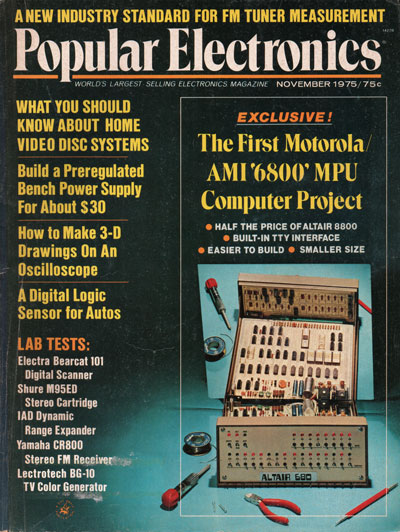
 |
Search | FAQ | US Titles | UK Titles | Memories | VaporWare | Digest | |||||||
| GuestBook | Classified | Chat | Products | Featured | Technical | Museum | ||||||||
| Downloads | Production | Fanfares | Music | Misc | Related | Contact | ||||||||
| CED in the History of Media Technology | ||||||||||||||

The birth of the modern personal computer is often traced to the publication of a cover article on the MITS Altair 8800 computer in the January 1975 issue of Popular Electronics. The November issue pictured above will be of greater interest to CED enthusiasts, as it contains an article on the reduced-cost Altair 680 followed by an article on the three competing VideoDisc systems of the time. This article included a publicity photo of the RCA Engineering Model 2 player.
In 1975, microcomputers like the Altair were not really intended to be used with video terminals, but were programmed in binary by flipping switches on the front panel, with the program output being displayed on front panel LED's. This was a difficult way to program the computer, and most users sought a means to use a keyboard. This was often accomplished by interfacing a surplus Baudot-type terminal such as the World War II vintage Teletype Model 15, which could be purchased inexpensively in the mid 1970's. Surplus Model 32 Teletypes from RCA's aborted CSD days could also be interfaced. The Altair heralded the arrival of Microsoft Corp. (initially named Micro-Soft) which developed the BASIC programming language for the machine.
Besides the Altair models, the other popular flip-switch computer of this period was the IMSAI 8800, essentially a clone of the Altair, which can be seen on the back of the CED title War Games. This movie came out in 1983, when both the MITS and IMS Associates had been gone for several years, but the IMSAI CPU with its blinking lights made a great prop for the movie.
RCA had their own kit computers based on the COSMAC microprocessor. These were the ELF I and ELF 2 computers. A series of construction articles were published starting in the August 1976 issue of Popular Electronics. The July 1977 issue provided plans for adding a PIXIE graphics capability to the ELF so it could display simple graphics on a TV.